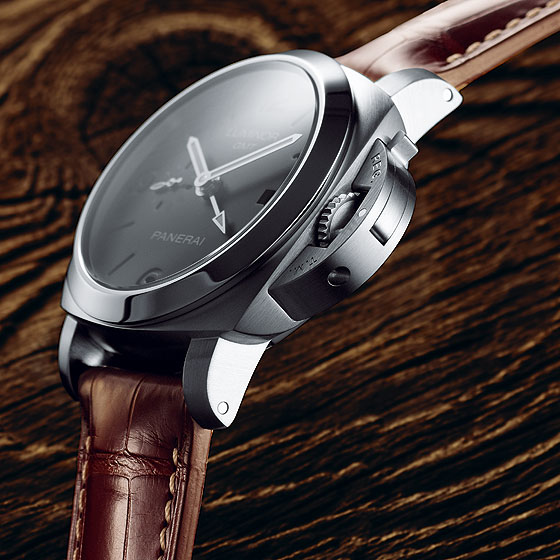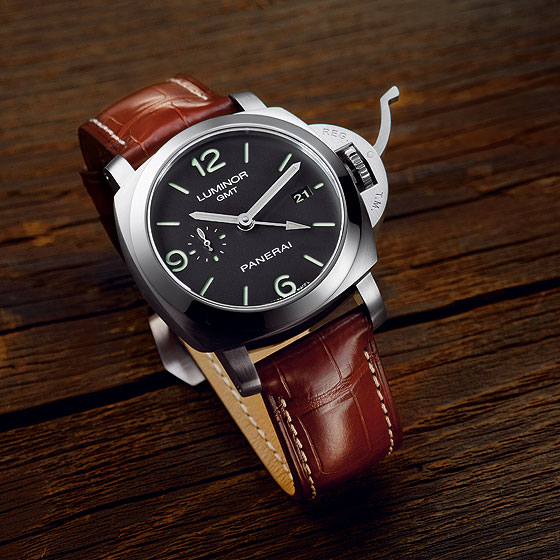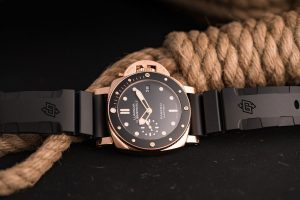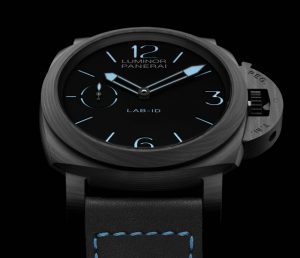
The Panerai Luminor 1950 3 Days GMT price , inspired by a vintage watch used by the Italian navy, features the brand’s P.9001 in-house movement. WatchTime put both wristwatch and caliber to the test in this feature from the WatchTime archives. Scroll down for the full report, accompanied by Nik Schölzel’s stunning original photos.
Caliber family P.9000, which debuted in 2009, is the second line of in-house movements developed by Panerai. Though their power reserve is shorter (three rather than eight days), these offer the convenience of automatic winding at significantly less expense than their predecessors in the P.2000 family. Caliber P.2003, in fact, holds a full 10 days’ worth of power, but the watch that it powers, the Panerai Luminor 1950 10 Days GMT, is nearly twice as expensive as the one we test here, the Luminor 1950 3 Days GMT.

Despite its lower price tag, the 3 Days GMT provides almost everything the 10 Days offers: a second time zone (but without a day-night display for the 12-hour hand), a power-reserve display (but positioned on the back and nonlinear) and a return-to-zero mechanism for the seconds hand, which is triggered when you extract the crown into the hand-setting position. Along with Caliber P.9001, which powers the watch in this test, the family includes the basic P.9000 (with no second time zone or power-reserve display) and the P.9002 (with power-reserve display on the front).
Typical characteristics of this Swiss-made, Italian-designed brand include a satin-finished and pillow-shaped case with a polished bezel, a protective stirrup with a lever used to press the crown firmly into the case, and a distinctively styled dial with large Arabic numerals and hour indices. The 3 Days GMT watch is a faithful interpretation of the original Panerai Luminor model, which debuted in 1950 as a watch for Italian Navy divers. but it isn’t essentially different from other Panerai watches. The unmistakable family resemblance of its products is both a strength and a weakness of this brand: if you aren’t fond of this one’s design, you probably won’t find any other Panerai model to suit you. On the other hand, every Panerai watch is immediately recognizable to the brand’s many fans. And judging by the staying power of Panerai’s retro design, the Luminor 3 Days will probably be just as appealing to collectors 10 years from now – which cannot be said about every contemporary watch.
Furthermore, the 3 Days GMT does boast several details that distinguish it from other Panerai watches. The color of the lettering on the date disk isn’t pure white, but slightly beige. Also, we were pleased to note that the 3 Days makes do without the magnifying lens found above the date displays of some other Panerai watches. Though this model has a variety of functions, its dial doesn’t look cluttered: the hand for the second time zone can be concealed under the hour hand for the local time, and the power-reserve display is positioned out of sight on the back. The crystals above the dials in other members of this collection are highly domed, but this one is only slightly curved, a difference that we appreciated.
The sandwich-style dial, another Panerai trademark, is as beautiful as ever, with an underlying layer of glow-in-the-dark Super-LumiNova topped by an opaque dial pierced with apertures for the numerals and indices that mark the hours. This gives the watch greater depth, keeps it faithful to its historic predecessors, and also explains the open, “stencil” design of the digits 6 and 9. This type of architecture guarantees that the numerals and indices glow uncommonly bright, which makes this watch very legible in the dark. The hour hand for the second time zone is coated with luminous material, as are the small seconds hand and its four accompanying indices. The time is also easy to read in daylight, though the lack of a minutes circle on the dial’s periphery means it cannot always be read as precisely as one might wish. The power-reserve display on the movement side uses a disk that rotates under a window; its color changes from black to red shortly before the energy is exhausted.
Careful scrutiny uncovered a few specks of dust on the hands, which were stamped from rather thin stock, which causes them to bend toward the polished eyelet at the center of the dial. There’s also an obvious break in the satin finishing above the lugs, which accept the crosspiece that holds the strap.
In all other respects, however, the case is excellently crafted. It also scores points for its quick-change system for the strap lugs. A special tool, delivered with the watch, can be used to press a button on the underside of each lug, making it easy to push out the crosspiece, remove the leather strap and install the alternate rubber one that is also included.
The broad, pre-mounted, machine-stitched crocodile-skin strap with cut edges is very well-made, as is the pronged buckle, which brings to mind an old-fashioned bottle opener. Some sharp edges become evident when you put it under a loupe, but you don’t notice them once the watch is fastened to your wrist.
All in all, and despite its large 44-millimeter diameter, the Panerai Luminor 1950 3 Days GMT is quite comfortable to wear, although the lugs don’t curve very far downward, which gives this big watch a tendency to slide back and forth along the wrist. Fortunately, our concerns that the crown protector might poke uncomfortably into the back of the wrist were unfounded.
The crown protector’s hinged lever also does not hinder the operation of the watch. It can be quickly opened, and it is easy to turn the large, easy-to-grasp crown while the watch is strapped to the wrist, making all the setting functions user-friendly. The mainspring can be manually wound when the crown is pulled out to its first extracted position; the hour hand for the local time can be reset in hourly increments when the crown is in its second position — a very practical feature for those who frequently travel outside their home time zone. The date display jumps forward or backward accordingly, so readjusting it is easy and quick, despite the absence of a genuine quick-adjustment mechanism.
When you pull the crown all the way out to its third position, the seconds hand on the subdial at 9 o’clock will race back to zero, the balance will stop oscillating, and the hours and minutes can be reset in the usual way. Afterward, you can simply swing the protective lever over the crown and use it to press it back into its secured position. Its return triggers the seconds hand to resume moving. Synchronizing this watch with an audible time signal or a radio-controlled clock is very easy thanks to the zero-return mechanism for the seconds hand, also used by A. Lange & Söhne and found on vintage Panerai watches. Like the return-to-zero function for the elapsed-time hands of a chronograph, it is triggered by a lever inside the movement, acting on a return-to-zero heart mounted on the staff of the seconds hand.
Caliber P.9001 is visible through a pane of sapphire in the caseback. Though the rotor is skeletonized, much of the movement’s inner workings are hidden because a large plate covers the entire mechanism except for the balance and its cock. A closer look reveals a sickle-shaped window for the escape wheel and another window through which one can see the pawl of the automatic winding mechanism. The rear view also includes the power-reserve display: a red field comes into view through the aperture whenever the energy supply shrinks to a critical level. The rotor, plate and balance cock are each decorated with a wave pattern. Combined with the blue filling of the engraved lettering, it creates an attractively technical look that matches this watch’s overall styling well. The polished heads of the silvery screws also look good, as do some of the other screws, which have been thermally blued. Some of the edges are beveled, others both beveled and polished: these look very nice, although they’re a bit narrow. The cover plate for the balance, which has been stamped from sheet metal and hasn’t been meticulously polished, is somewhat less impressive.
The bidirectionally winding rotor uses pawls and runs over low-wear ceramic ball bearings. It supplies power to the barrels, which (as the watch’s name indicates) amass enough energy to keep the watch running for 72 hours. A total of 227 components — including 29 jewels for ideal reduction of friction — comprise the movement. Four screws along the rim provide the solution to the problem of finely adjusting the balance without the need for an index tail. Until a few years ago, this detail was reserved for watches in the upper echelons of haute horlogerie.
Our rate test revealed that Panerai has done a good job of finely adjusting the movement. Though it gained eight seconds on the wrist, its average gain on the timing machine was a mere 3.7 seconds. The greatest deviation among the various positions (five seconds) is quite respectable, too. The amplitude remained high in all positions.
For a watch with a manufacture movement, the price is reasonable, only moderately more expensive than the earlier models that contained ETA movements. Few watches with in-house movements in this price range offer a comparable range of functions.







